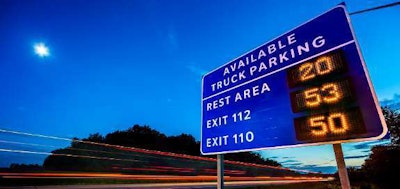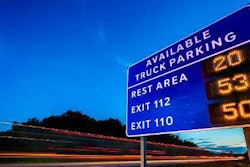
The verdict in the image above was issued by owner-operator and drivers readers of CCJ sister magazine Overdrive, attendant to an investigation of where the decades-old problem of truck parking is most intense today. For years, it was confined largely to congested metropolitan areas, especially on certain Eastern seaboard and California lanes. Studies now show that it has worsened in those areas and spread into other locales. Eighty-three percent of the magazine’s readers noted simply that “it’s bad all over” when it comes to parking.
What’s happening in response:
- The creation of new parking spaces is accelerating, with the public/private balance continuing to shift to private capacity.
- More informational programs to deliver real-time parking space availability are being implemented.
- Some major truck stop chains now offer paid reservations.
Data show a large divergence among states in available public and private parking spaces, from a high of 171 spaces per 100,000 miles of annual truck vehicle miles traveled in Montana to just 31 in Rhode Island. Or, measured by mile of National Highway System roadway, the range of spaces runs from 359 per 100 miles in Louisiana to, again at the top of the worst-states list, Rhode Island’s 39.
One recent catalyst was the August release of the Jason’s Law Truck Parking Study, mandated in the 2012 MAP-21 highway bill. If the study has done anything, it’s identified where the need is most pressing across the nation, say parking advocates.
TRUCK STOP EXPANSION
Major truck stop chains, notably Love’s Travel Stops, continue to expand. The company has about 17,700 spaces at more than 350 locations, about 50 of them being C-store-only locations. “We’re on track to open in the neighborhood of 30 locations this year,” says Love’s spokesperson Kealey Dorian. In 2017, an estimated 4,100 parking spaces will be added and available at new facilities.
Some of that growth is in secondary markets, sized on the low end of Love’s typical 60- to 110-space stops. “We’re committed to expanding everywhere, not just the major thoroughfares,” Dorian says. She acknowledges driver criticism that many of the new major market stops are too far from metro areas.
TravelCenters of America, operator of TA and Petro Stopping Centers, also has been in expansion mode; the company added 2,800 spaces over the last three years. A new Petro in Gary, Ind., added 405 new spaces to “a very congested I-80/I-90 corridor,” says spokesman Tom Liutkus.
In Virginia, a top 20 problem state for parking in Overdrive’s analysis, a TA Petro location along I-81 is adding another 300 spaces. Liutkus says three new facilities will open in 2016 in three other states known for parking problems: Tennessee, Texas and Illinois.
This year, in addition to beginning a test run of paid-parking reservations at 10 sites around the country, Pilot Flying J has added about 18 sites with an average 110 parking spaces in each. In 2016, another 25 sites of similar size are coming online.
 In 2002, when the Federal Highway Administration last studied parking inventory in depth, private truck stops and public rest areas accounted for 77 percent and 23 percent of total capacity, respectively. Today, per the Jason’s Law study, the distribution of the 308,920 total truck parking spaces nationwide shows 36,222, or only 12 percent, at rest areas and the 88 percent balance at private truck stops. Demand trends measured on a per-stop basis are trending toward rest areas, however, with the 30-minute break requirement and other factors — examine those trends via this link.
In 2002, when the Federal Highway Administration last studied parking inventory in depth, private truck stops and public rest areas accounted for 77 percent and 23 percent of total capacity, respectively. Today, per the Jason’s Law study, the distribution of the 308,920 total truck parking spaces nationwide shows 36,222, or only 12 percent, at rest areas and the 88 percent balance at private truck stops. Demand trends measured on a per-stop basis are trending toward rest areas, however, with the 30-minute break requirement and other factors — examine those trends via this link.AVAILABILITY INFO SYSTEMS
In the public arena, the MAP-21 highway bill’s Jason’s Law language not only required the recently released study but also created new avenues for federal funding of truck-parking initiatives, both public and private.
Projects funded by programs created by the highway bill prior to MAP-21 are seeing action today, with some well in place, notably an effort in Michigan receiving $4.5 million in federal funding that is now deployed on I-94 to show available truck- and rest-stop spaces via road signs and other methods. In late October, $25 million in additional funding was announced for an eight-state collaborative project to include Wisconsin and Minnesota’s ongoing work and to follow Michigan’s lead in the remaining roughly contiguous states of Ohio, Kentucky, Indiana, Kansas and Iowa.
Matt Junak of infrastructure firm HNTB, contracted with Michigan DOT on its parking info system, says his company is working with Wisconsin, Minnesota and Kansas in the Midwest and farther afield. In Florida, the firm is consulting with FDOT on a project along the I-95 and I-4 corridors that may involve road signs but will share information on facilities that aren’t truck stops.
Florida, Junak says, could have live availability information “operational a year from now at least, with a data feed that can be integrated into their traveler information system” or private in-cab-delivery devices.
In Michigan, a test is under way with the James Burg Trucking fleet, running regularly between Detroit and Chicago, that Junak says has transponders installed in the fleet’s trucks to share parking data with drivers.
A NATIONAL COALITION
The first meeting of the National Coalition on Truck Parking was Nov. 10. The agenda included the establishment of regional task forces to recommend actions to improve parking in each region.
Hope Rivenburg, widow of slain trucker Jason Rivenburg, the namesake of the Jason’s Law legislation, has pledged to bring truckers’ concerns to coalition meetings as they proceed regionally. Rivenburg has been at the front of the parking issue since her husband’s 2009 slaying at an abandoned facility near Orangeburg, S.C., where he was parked overnight.
The Jason’s Law parking study “gives us a good starting point,” Rivenburg says. “If you take the worst state with the biggest shortage of parking” and then “move on down the list,” meaningful change could occur, she says.
Explore the issue in-depth via the hub page of CCJ sister magazine Overdrive at this link. Access data on where the parking shortage is most prominent in an interactive map of the 48 continental U.S. states at this link.











